Three Poses to Watch if You Have Shoulder Pain
Yoga can be wonderful for our shoulders. Heart opening poses can stretch tight pec muscles and strengthen our rhomboids by bringing the shoulder blades closer together. Planks and chaturangas can strengthen the shoulder girdle muscles, including the lats, pecs and serratus anterior. When we move mindfully, we can engage our rotator cuff muscles to stabilize the position of the humerus in the shoulder socket.
Pain in the Shoulder
But if there is pain in the shoulder, this is indicating that something is not moving efficiently. (The following concepts are based on the work of Shirley Sahrmann, PhD, PT, FAPTA.)
Just like a machine, your body’s joints work best if they are moved with precision. If there is instability at any one point, the joint will wear out more quickly. This is often referred to as joint “wear and tear.” People speak of this as if it were inevitable, but it is not entirely out of our control.
With respect to the shoulder, we can learn to improve stability within the joint and make it less vulnerable to “wear and tear,” or diagnoses such as tendonitis, bursitis, and shoulder impingement.
Mechanics
When there is pain at the top or front of the shoulder, faulty movement at the humerus is usually part of the problem. As the arm is raised, the part of the humerus in the socket is supposed to stay in one place on that glenoid fossa. If there is a muscle imbalance, the humerus starts to slide around in the glenoid. It is hypermobile. This is the joint sloppiness that causes “wear and tear.”
How does muscle imbalance in the shoulder occur?
Depending on our activities, we use some muscles more than others. If we work a lot with our arms in front of us, the front body muscles get tight and strong. If we do a lot of weighted shoulder abduction (arms out to the sides), the deltoids get tight and strong. If we work a lot with our arms at shoulder height, our upper traps will likely be tight and strong. Right handers have stronger, more efficient muscles on the right side of the body, and vice-versa for left handers.
It is difficult to keep our bodies in perfect balance, but yoga gives us the opportunity to be aware of these imbalances, and correct them before they become debilitating.
Common Imbalances for Yogis
If you have pain on the top or front of the shoulder, it is likely that the humerus is moving too far upward and/or forward in the socket. As the bone pushes upward or forward, it can pinch the biceps or supraspinatus tendon into the bony structure above it (the acromion), causing inflammation.
See research about the mechanics of the glenohumeral joint.
Strengthening muscles that pull upward on the humerus will make this problem worse. Deltoids that are too strong in relation to the rotator cuff will increase your impingement. (Stop doing movements where you bring your arms straight out to the sides, especially with weights).
Activating muscles that will keep a downward pull on the humerus as the arm is raised will help this situation. These are the muscles of the rotator cuff.
Three Poses to Modify if You Have Shoulder Pain
These are poses where the humerus is vulnerable to moving forward and/or upward too much. Pay attention to the position of the top of the humerus versus the bottom of the humerus (near the elbow).
Humble Warrior
When we interlace the fingers behind the back and then try to bring the hands up to the ceiling, the humeri are very likely to move forward in the sockets.

Modify by not bringing the hands so far upward, and then the humeri stay in a better position.
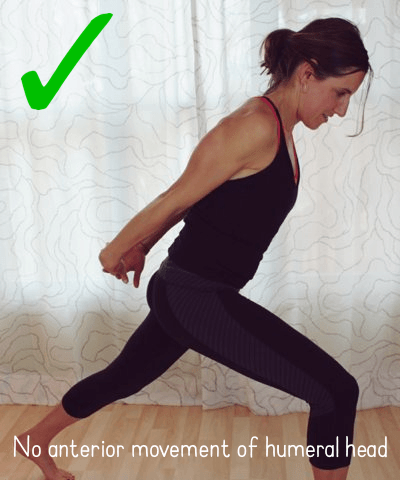
Chaturanga
In this pose, I am not stabilizing well at the shoulders, and the tops of the shoulders are coming down too far.
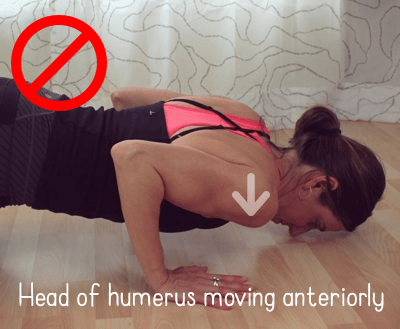
Here I have pulled the humerus back into the sockets so they don’t move forward. If you do not have the strength to do this, modify by putting your knees down.
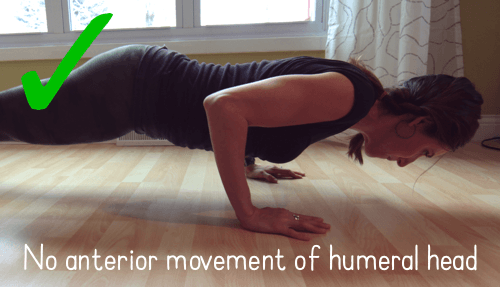
Side Plank
This is a tricky one! Watch how the supporting shoulder gets pushed forward of the elbow.
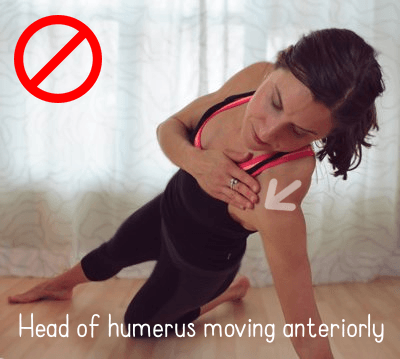
If you find you cannot hold the humerus back in the socket by pulling inward with your muscles, you need to modify by putting your bottom knee down until you gain the necessary strength in the shoulder joint stabilizers.
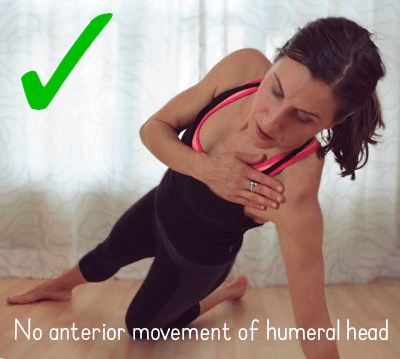
If you are having shoulder problems, it is also advisable to avoid binding poses, because they also tend to push the head of the humerus forward and up. With these small modifications, you will decrease achiness in the shoulders, improve shoulder stability and restore precision of motion to the shoulder joints.

Comments